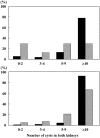Unified criteria for ultrasonographic diagnosis of ADPKD
- PMID: 18945943
- PMCID: PMC2615723
- DOI: 10.1681/ASN.2008050507
Unified criteria for ultrasonographic diagnosis of ADPKD
Abstract
Individuals who are at risk for autosomal dominant polycystic kidney disease are often screened by ultrasound using diagnostic criteria derived from individuals with mutations in PKD1. Families with mutations in PKD2 typically have less severe disease, suggesting a potential need for different diagnostic criteria. In this study, 577 and 371 at-risk individuals from 58 PKD1 and 39 PKD2 families, respectively, were assessed by renal ultrasound and molecular genotyping. Using sensitivity data derived from genetically affected individuals and specificity data derived from genetically unaffected individuals, various diagnostic criteria were compared. In addition, data sets were created to simulate the PKD1 and PKD2 case mix expected in practice to evaluate the performance of diagnostic criteria for families of unknown genotype. The diagnostic criteria currently in use performed suboptimally for individuals with mutations in PKD2 as a result of reduced test sensitivity. In families of unknown genotype, the presence of three or more (unilateral or bilateral) renal cysts is sufficient for establishing the diagnosis in individuals aged 15 to 39 y, two or more cysts in each kidney is sufficient for individuals aged 40 to 59 y, and four or more cysts in each kidney is required for individuals > or = 60 yr. Conversely, fewer than two renal cysts in at-risk individuals aged > or = 40 yr is sufficient to exclude the disease. These unified diagnostic criteria will be useful for testing individuals who are at risk for autosomal dominant polycystic kidney disease in the usual clinical setting in which molecular genotyping is seldom performed.
Figures

 ); diagnosed by molecular genotyping. (Top) Percentage of affected individuals who had different number of total renal cysts and were between 15 and 29 yr of age (n = 113 for PKD1 group; n = 41 for PKD2 group). (Bottom) Percentage of affected individuals with different number of total renal cysts between 30 and 59 yr of age (n = 170 for PKD1 group; n = 121 for PKD2 group). Affected individuals with PKD2 had a milder renal cyst burden compared with affected indivduals with PKD1 in both age groups (P < 0.0001 by Fisher exact test).
); diagnosed by molecular genotyping. (Top) Percentage of affected individuals who had different number of total renal cysts and were between 15 and 29 yr of age (n = 113 for PKD1 group; n = 41 for PKD2 group). (Bottom) Percentage of affected individuals with different number of total renal cysts between 30 and 59 yr of age (n = 170 for PKD1 group; n = 121 for PKD2 group). Affected individuals with PKD2 had a milder renal cyst burden compared with affected indivduals with PKD1 in both age groups (P < 0.0001 by Fisher exact test).Comment in
-
Unified ultrasonographic diagnostic criteria for polycystic kidney disease.J Am Soc Nephrol. 2009 Jan;20(1):6-8. doi: 10.1681/ASN.2008111164. Epub 2008 Dec 10. J Am Soc Nephrol. 2009. PMID: 19073819 No abstract available.
References
-
- Igarashi P, Somlo S: Genetics and pathogenesis of polycystic kidney disease. J Am Soc Nephrol 13: 2384–2398, 2002 - PubMed
-
- Parfrey PS, Bear JC, Morgan J, Cramer B, McManamon P, Gault H, Churchill D, Singh M, Hewitt R, Somlo S, Reeders S: The diagnosis and prognosis of autosomal dominant polycystic kidney disease. N Engl J Med 323: 1085–1090, 1990 - PubMed
-
- Ravine D, Walker RG, Gibson RN, Forrest S, Richards R, Friend K, Sheffield L, Kincaid-Smith P, Danks D: Phenotype and genotype heterogeneity in autosomal dominant polycystic kidney disease. Lancet 340: 1330–1333, 1992 - PubMed
-
- Hughes J, Ward CJ, Peral B, Aspinwall R, Clark K, San Millan JL, Gamble V, Harris P: The polycystic kidney disease 1 gene encodes a novel protein with multiple cell recognition domains. Nat Genet 10: 151–160, 1995 - PubMed
-
- International Polycystic Kidney Disease Consortium: Polycystic kidney disease: The complete structure of the PKD1 gene and its protein. Cell 81: 289–298, 1995 - PubMed
Publication types
MeSH terms
Substances
LinkOut - more resources
Full Text Sources
Other Literature Sources
Medical
Miscellaneous

